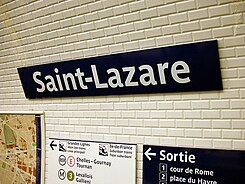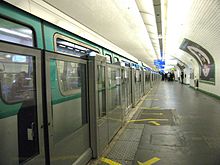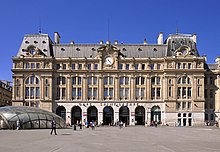Saint-Lazare (Paris Metro)
| Saint-Lazare | |
|---|---|
| Metro station in Paris | |

|
|
| Basic data | |
| Arrondissement | VIII |
| Opened | October 14, 1904 |
| Tracks (platform) | 8 (side platform) |
| Security features | Platform screen doors |
| Coordinates | 48 ° 52 '32 " N , 2 ° 19' 32" E |
| use | |
| Line (s) |
|
| Switching options |
|
The Saint-Lazare metro station is an underground transfer station for the Paris Métro . It is served by lines 3 , 12 , 13 and 14 . With around 95,000 passengers a day, in 2004 it was the second busiest underground station on the Metro. At Paris-Saint-Lazare station, you can change to long-distance and local trains going west, at the underground station Haussmann - Saint-Lazare to line E of the S-Bahn- like RER . A pedestrian tunnel leads to the nearby Auber RER station , which is served by the RER A trains.
location
The metro hub is located at the intersection of the Quartier de la Madeleine and the Quartier de l'Europe in the 8th arrondissement with the Quartier Saint-Georges and the Quartier de la Chaussée-d'Antin in the 9th arrondissement of Paris . The station of line 3 is located lengthways under the rue de Rome at the level of rue Saint-Lazare, that of line 14 under the long-distance train station. To the east of line 3, the station for line 13 was built alongside rue Saint-Lazare at the height of the station building of the long-distance train station. A little off the beaten track, under Rue Saint-Lazare east of its intersection with the Rue du Havre - Rue d'Amsterdam, is the station for line 12.
Surname
The underground station is named after the Saint-Lazare long-distance train station and the Rue Saint-Lazare there. The latter led to the Clos de Saint-Lazare, an approximately 32 hectare fenced area with a hospital for lepers . This leprosy bore the name of the "holy" Lazarus of Bethanien (fr: Saint Lazare de Béthanie), who was called to help against leprosy, but was mistaken for the "poor" Lazarus .
history
On October 19, 1904, the first section of line 3 from Villiers to Père Lachaise - and with it its Saint-Lazare station - was opened by the Compagnie du chemin de fer métropolitain de Paris (CMP). The competing railway company Société du chemin de fer électrique souterrain Nord-Sud de Paris (North-Sud) started its line A (since 1931: line 12) on November 5, 1910. Both stations were under water during the floods of the Seine in 1910, and again in 1914.
The current line 13 with its station Saint-Lazare was opened on February 26, 1911 as line B from the north-south. Saint-Lazare was initially the southern terminus of the route leading to Porte de Saint-Ouen . The southern extension, initially to Miromesnil , did not take place until June 27, 1973. In 2006, platform screen doors were installed in the station on line 13 initially on a trial basis, and then until 2012 finally .
After the original line 14 was added to line 13 in 1976, the line number could be re-occupied. The new line 14, which opened on October 15, 1998, reached its current western terminus of Saint-Lazare on December 16, 2003. In the course of the construction of this station, the subway station underwent extensive renovations. New connecting corridors were created between the individual stops, which were very generously dimensioned and modernly equipped.
description
All stations have side platforms on two main tracks. In contrast to the elliptical cross-section, which is more common in Paris , the station on line 3 has a horizontal metal ceiling. Longitudinal girders, which carry small vaults made of bricks, rest on iron support beams that are perpendicular to the direction of travel. It is 75 m long, lies in a gentle curve and is crossed almost at right angles by the route tunnel of line 12.
The stations of lines 12 and 13 are located under elliptical, largely white-tiled vaults. In contrast to similar stations set up by the CMP, the side walls do not follow the curvature of the ellipse, but run vertically in the lower area. Typically for the underground stations in the north-south, the stations were optically more elaborate than those of the CMP, but they are now much simpler. Because of the overhead line originally on the north-south routes , which was attached to frames attached to the ceiling, they are slightly higher than the CMP stations. They also have the original Parisian standard length of 75 m, sufficient for five-car trains.
At 120 m, the station on line 14 is much longer. It lies under a round vaulted ceiling that is crossed in the middle by a pedestrian passage. Because of the operation with fully automatic trains, it was equipped with platform screen doors from the start.
With the construction of line A, a spacious underground hall for transfer passengers was created between the successive stations of today's lines 12 and 13. The building, known as the “Rotonde”, is located between the stations of lines 12 and 13 under the Place du Havre. From there, in addition to several exits to the street, an underground passage leads into the counter hall of the long-distance train station. A pedestrian tunnel also leads there from the north head of the line 3 station. The Havre - Caumartin , Saint-Augustin (both line 9 ) and Opéra (lines 7 and 8 ) underground stations can be reached on foot via connecting walkways .
Lines 12 and 13 form a cross with the “rotonde” at the intersection of the axes, with the stations lying on the horizontal axis (line 13 to the left of the intersection, line 12 to the right of it). Below the "Rotonde" their routes turn in tight curves to the south (line 12) or north (line 13). They are connected to one another via an operating track that runs under the "Rotonde". Line 12 also has a simple track change immediately to the west of its station . Line 14 has two parking and turning tracks to the northeast of its station, in front of which there is a double track change in the form of an "X".
vehicles
As a result of the accident at Couronnes station , line 3 was equipped with vehicles that ran on bogies from the start . The five-car trains consisted of three multiple units and two trailer cars . They were later replaced by Sprague-Thomson trains , which ran there until 1967. In that year, Line 3 was the first to receive the new MF 67 series, which runs classically on steel rails . The trains, which were renovated between 2005 and 2008, will continue to be in service there in 2020; from 2028 they are to be replaced by vehicles from the MF 19 series.
Trains of the north-south type Sprague-Thomson ran on lines 12 and 13, which differed in several respects from the Sprague-Thomson vehicles of the CMP. A striking feature was the power supply of the leading railcar by means of a pantograph . After the takeover of Nord-Sud by CMP, this type of business was given up in the 1930s. In the 1970s, the north-south trains on line 12 were eliminated in favor of the Sprague-Thomson standard design, and in 1977 modern trains of the MF 67 series came onto the line.
New trains of the first post-war MA series were running on Line 13 as early as 1952 . They gave way to MF 67 trains in 1976, and in 1978 the line was the first to receive the MF 77 series, which was still in service in 2017 .
Line 14 is operated with driverless, rubber-tyred trains of the MP 89 CA and MP 05 series .
Remarks
- ↑ Gare du Nord is the Paris metro station with the largest number of passengers
- ↑ CA means "Conduite Automatique" (automatically controlled), in contrast to the driver-controlled type MP 89 CC
Web links
- Plan of the platforms and tracks at carto.metro.free.fr
literature
- Gérard Roland: Stations de métro. D'Abbesses à Wagram . 2003, ISBN 2-86253-307-6 .
Individual evidence
- ↑ Sommaire. (PDF; 1.1 MB) (No longer available online.) P. 16 , archived from the original on June 17, 2012 ; Retrieved July 16, 2010 (French). Info: The archive link was inserted automatically and has not yet been checked. Please check the original and archive link according to the instructions and then remove this notice.
- ^ A b Gérard Roland: Stations de métro d'Abbesses à Wagram . Christine Bonneton, Clermont-Ferrand 2011, ISBN 978-2-86253-382-7 , pp. 194 .
- ↑ a b Jean Tricoire: Un siècle de métro en 14 lignes. De Bienvenüe à Météor . 2nd Edition. La Vie du Rail, Paris 2000, ISBN 2-902808-87-9 , p. 165 .
- ↑ Jean Tricoire: op. Cit. , P. 294.
- ↑ Sur la ligne 13, les portes s'automatisent at leparisien.fr, accessed on April 26, 2017
- ^ A b c Brian Hardy: Paris Metro Handbook . 3. Edition. Capital Transport Publishing, Harrow Weald 1999, ISBN 1-85414-212-7 , pp. 36 .
- ↑ Jean Tricoire: op. Cit. , P. 292.
- ^ Jean Robert: Notre Métro . 2nd Edition. J. Robert, Neuilly-sur-Seine 1983, p. 125 .
- ↑ Jean Tricoire: op. Cit. , P. 293.
- ↑ Jean Tricoire, op. Cit. , P. 86.
- ↑ Jean Tricoire: op. Cit. , P. 168.
- ↑ Jean-Gabriel Bontinck: Métro: ligne par ligne, découvrez quand les nouvelles arriveront rames. In: Le Parisien . April 11, 2019, accessed on June 7, 2020 (Fri-FR).
| Previous station | Paris metro | Next station |
|---|---|---|
|
Europe ← Pont de Levallois - Bécon |
|
Havre - Caumartin Gallieni → |
|
Trinité - d'Estienne d'Orves ← Front Populaire |
|
Madeleine Mairie d'Issy → |
|
Liège ← Saint-Denis - Université or Asnières - Gennevilliers - Les Courtilles |
|
Miromesnil Châtillon - Montrouge → |
| final destination |
|
Madeleine Olympiades → |







